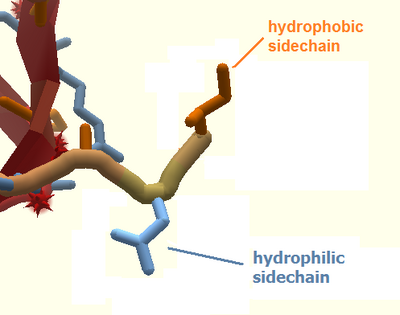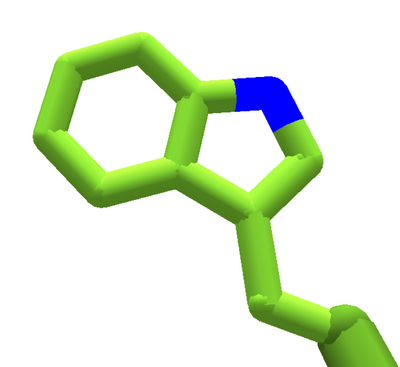
Sidechains are the shapes that stick out from the backbone of a protein.
Some sidechains have only one position, but others can be "flipped" to multiple positions. In Foldit, you can click and drag on a sidechain to move it to another position. Shake and wiggle can also help move sidechains to their best position. Other tools can also cause sidechains to move to different positions.
Sidechains can be either hydrophobic or hydrophilic. Using its default color options, Foldit shows hydrophobic sidechains in orange and hydrophilic sidechains in blue.
It's important for hydrophobic sidechains to be buried in the core of the protein.
The Amino Acid Gallery shows all the different sidechains seen in Foldit. The sidechain is what makes each amino acid different.
The sidechains in a protein can bond with each other, helping to stabilize the protein. Sidechains help determine what other chemicals a protein interacts with (including other proteins), which is key to the function of the protein.
Sidechains have different positions called rotamers. The shake moves one or more sidechains to what seems to be a better rotamer position. The "wiggle sidechains" option of the wiggle tool can make further small adjustments to sidechain position. The Foldit Lua function rotamer.SetRotamer can be used in a recipe to set a specific rotamer position.
Foldit puzzles may also contain DNA and RNA, which are chains of nucleotides usually referred to as bases. The base portion of a DNA or RNA nucleotide is similar to the sidechain of an amino acid. Many Foldit tools work on bases in the same way they do on sidechains.
Visualizing sidechains[]

Tryptophan, the amino acid with the largest sidechain, shown in EnzDes coloring
The Foldit view options control when sidechains appear and what they look like. For looking at sidechains, the "View Sidechains" option "Show All (Slow)" is best. You should hide sidechains using "Don't Show (Fast)" to speed up tools like shake and wiggle, or when running a recipe.
In the standard "cartoon" view, sidechains appear to be made of thin tubes. The bends in the tubes represent atoms. Only the "heavy" non-hydrogen atoms are shown by default. The tubes represent "electron density", the area where the electrons holding the atoms together are most likely to be.
Sidechains may be very short, like the single carbon sidechain of alanine, or even invisible, as in glycine. At the other end of the spectrum, sidechains can be comparatively large and complex, like the hexagon plus pentagon sidechain of tryptophan.
Different view options can help reveal more sidechain features, which can be helpful in some cases.
The most common sidechain atom is carbon, but sidechains can include oxygen, nitrogen, and sulfur as well. The EnzDes and CPK coloring options show oxygen in red, nitrogen in dark blue, and sulfur in yellow.
Some view options with "+H" in their names reveal the hydrogen atoms attached to the sidechains. This can be helpful in understanding hydrogen bonding between sidechains.